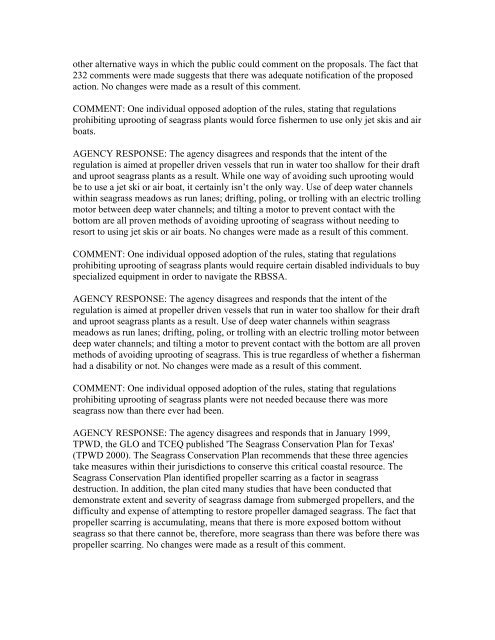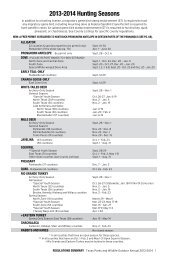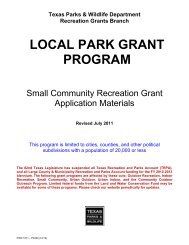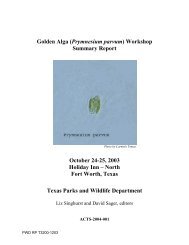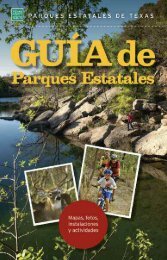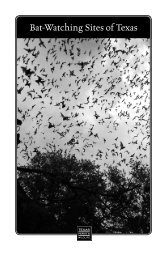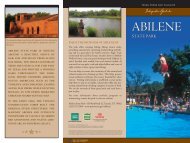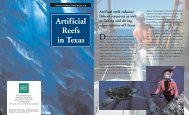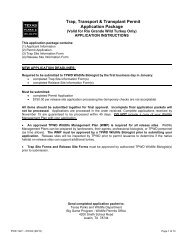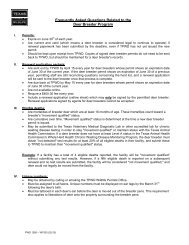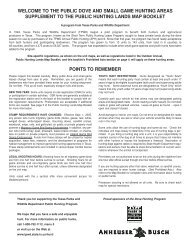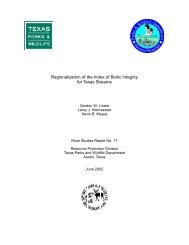Chapter 57. FISHERIES - Texas Parks & Wildlife Department
Chapter 57. FISHERIES - Texas Parks & Wildlife Department
Chapter 57. FISHERIES - Texas Parks & Wildlife Department
You also want an ePaper? Increase the reach of your titles
YUMPU automatically turns print PDFs into web optimized ePapers that Google loves.
other alternative ways in which the public could comment on the proposals. The fact that<br />
232 comments were made suggests that there was adequate notification of the proposed<br />
action. No changes were made as a result of this comment.<br />
COMMENT: One individual opposed adoption of the rules, stating that regulations<br />
prohibiting uprooting of seagrass plants would force fishermen to use only jet skis and air<br />
boats.<br />
AGENCY RESPONSE: The agency disagrees and responds that the intent of the<br />
regulation is aimed at propeller driven vessels that run in water too shallow for their draft<br />
and uproot seagrass plants as a result. While one way of avoiding such uprooting would<br />
be to use a jet ski or air boat, it certainly isn’t the only way. Use of deep water channels<br />
within seagrass meadows as run lanes; drifting, poling, or trolling with an electric trolling<br />
motor between deep water channels; and tilting a motor to prevent contact with the<br />
bottom are all proven methods of avoiding uprooting of seagrass without needing to<br />
resort to using jet skis or air boats. No changes were made as a result of this comment.<br />
COMMENT: One individual opposed adoption of the rules, stating that regulations<br />
prohibiting uprooting of seagrass plants would require certain disabled individuals to buy<br />
specialized equipment in order to navigate the RBSSA.<br />
AGENCY RESPONSE: The agency disagrees and responds that the intent of the<br />
regulation is aimed at propeller driven vessels that run in water too shallow for their draft<br />
and uproot seagrass plants as a result. Use of deep water channels within seagrass<br />
meadows as run lanes; drifting, poling, or trolling with an electric trolling motor between<br />
deep water channels; and tilting a motor to prevent contact with the bottom are all proven<br />
methods of avoiding uprooting of seagrass. This is true regardless of whether a fisherman<br />
had a disability or not. No changes were made as a result of this comment.<br />
COMMENT: One individual opposed adoption of the rules, stating that regulations<br />
prohibiting uprooting of seagrass plants were not needed because there was more<br />
seagrass now than there ever had been.<br />
AGENCY RESPONSE: The agency disagrees and responds that in January 1999,<br />
TPWD, the GLO and TCEQ published 'The Seagrass Conservation Plan for <strong>Texas</strong>'<br />
(TPWD 2000). The Seagrass Conservation Plan recommends that these three agencies<br />
take measures within their jurisdictions to conserve this critical coastal resource. The<br />
Seagrass Conservation Plan identified propeller scarring as a factor in seagrass<br />
destruction. In addition, the plan cited many studies that have been conducted that<br />
demonstrate extent and severity of seagrass damage from submerged propellers, and the<br />
difficulty and expense of attempting to restore propeller damaged seagrass. The fact that<br />
propeller scarring is accumulating, means that there is more exposed bottom without<br />
seagrass so that there cannot be, therefore, more seagrass than there was before there was<br />
propeller scarring. No changes were made as a result of this comment.


